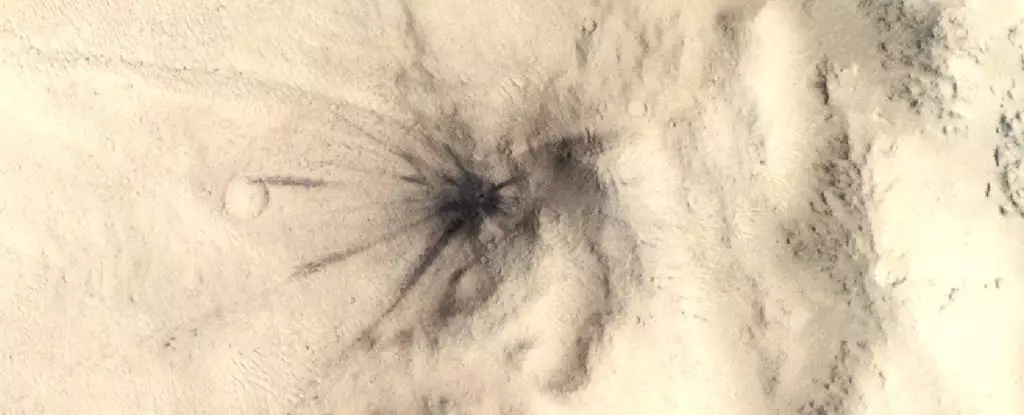The exploration of Mars has captivated humanity for decades, drawing scientists and researchers into the depths of its mysterious geology and history. A recent study utilizing artificial intelligence (AI) to analyze seismic data is rewriting our understanding of this enigmatic planet. Contradicting long-held assumptions that marsquakes primarily stem from tectonic activity, this research unveils a new perspective on how impacts from space objects may play a significant role in shaping the Martian landscape. The implications of these findings extend beyond merely cataloging seismic activity; they fundamentally challenge our interpretations of Mars’ geological evolution and its core.
The turning point in this research comes from harnessing machine learning algorithms to sift through vast amounts of seismic data collected by the Mars InSight lander, operational from 2018 to 2022. This state-of-the-art seismometer was tasked with detecting the quakes rumbling beneath Mars’ surface. Researchers, led by planetary scientist Valentin Bickel from the University of Bern, uncovered that many significant marsquakes recorded during this period correlated with the formation of new impact craters, rather than originating from traditional geological activity.
Using images captured by the HiRISE instrument on the Mars Reconnaissance Orbiter, the team identified 123 new craters and found that 49 of the seismic events detected by InSight corresponded with these impacts. This compelling evidence indicates that the rate of impacts on Mars is vastly higher than previously estimated—ranging from 1.6 to 2.5 times more frequent. Such a revelation leads to a reconsideration of the past geological narrative surrounding Mars, suggesting a more active and dynamic history than anyone has previously accounted for.
Previously, scientists had theorized that Mars was nearing geological dormancy, with little activity beyond the occasional quake attributed to tectonic movements. However, the recent findings have prompted a complete reevaluation of this perspective. As Bickel explains, these insights into the causes of marsquakes carry profound impacts on our understanding of Mars’ internal dynamics, including its gooey core. It becomes critical to explore how these influences compare with Earth and other rocky planets, potentially revealing a more complex interplay of factors that shape planetary evolution across the solar system.
The research ventured deeper, focusing on one notable impact—a 21.5-meter crater located near the volcanic region of Cerberus Fossae. This region, previously thought to produce high-frequency seismic signals from internal tectonic activities, is now seen through a different lens. The new data implies that some of these high-frequency signals might actually arise from meteoroid impacts, leading to an increased awareness of the planet’s seismic landscape. The revelation that impacts can generate seismic waves that penetrate well into Mars’ mantle adds another layer of complexity to how scientists map and interpret Martian geology.
One of the study’s most striking findings pertained to the propagation of seismic waves through Mars. Contrary to earlier beliefs that these waves were limited to the planet’s crust, it was discovered that impact-generated waves could travel considerable distances, creating what the researchers refer to as a “seismic highway.” This finding suggests that previously recorded marsquakes could originate from regions far removed from InSight’s location. The implications for planetary geology are enormous, indicating that the interior of Mars may not be as structurally simple as once thought.
This refined understanding of seismic wave propagation bears significant consequences for future geological explorations. By analyzing how waves from impacts traverse different material densities within Mars, scientists can enhance their maps of the planet’s internal contributions. The complexities of these findings compel scientists to rethink established models and adapt their theories to accommodate a richer tapestry of Martian dynamics.
As we continue to unravel the profound mysteries of Mars, this latest research breaks ground for an exciting new chapter in planetary science. With emerging data pointing toward a more active Martian environment—one shaped significantly by impact events—scientists are nudged towards rewriting narratives of planetary evolution and formation. The findings emphasize the need for further exploration and analysis, as they not only expand our understanding of Mars but also invite comparisons with other rocky planets, enhancing our comprehension of the solar system’s diverse geological narratives. As we refine our approach to Martian exploration, the quest for knowledge continues, promising to unlock the deeper secrets hidden beneath the planet’s dusty surface.


Leave a Reply